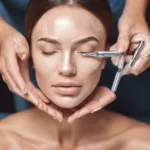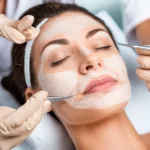24 November 2023
A Comprehensive Guide to the Benefits, Risks, and Procedure of Dermaplaning
In the pursuit of flawless skin, individuals are constantly seeking out new and innovative skincare treatments. One such treatment that has gained popularity in recent years is dermaplaning. This minimally invasive procedure involves the gentle shaving away of the top layers of skin, revealing a brighter and smoother complexion underneath. With potential benefits ranging from reducing the appearance of acne scars to exfoliating dull skin and removing unwanted hair, dermaplaning has become a go-to treatment for those looking to achieve a youthful and radiant glow. In this article, we will delve into the world of dermaplaning, exploring its benefits, risks, and the steps involved in the procedure.
What is Dermaplaning?
During a dermaplaning session, a dermatologist or healthcare provider utilizes a handheld surgical device called a dermatome to delicately shave off thin layers of skin and hair. This procedure can be performed on specific problem areas or the entire face, depending on the individual’s needs. Dermaplaning is often sought after to reduce the appearance of fine lines, wrinkles, and acne scars, providing a rejuvenated and smoother complexion.
Dermaplaning vs. Dermabrasion vs. Microdermabrasion: What’s the Difference?
While dermaplaning, dermabrasion, and microdermabrasion are all methods of sloughing off the top layers of skin, they differ in terms of the tools used and the depth of exfoliation. Microdermabrasion involves the use of microcrystals or a diamond-tipped device to remove dead skin cells, followed by a vacuum-like suctioning process. Dermabrasion, on the other hand, utilizes an electric rotating brush to remove the uppermost layers of skin. Dermaplaning, with its scalpel-like dermatome, offers deeper exfoliation than microdermabrasion, effectively removing both skin and hair.
Benefits of Dermaplaning
The potential benefits of dermaplaning are numerous. This procedure can help reduce the appearance of fine lines, acne scars, and pitted skin. Additionally, dermaplaning brightens dull and dry skin, removes unwanted vellus hair (commonly known as “peach fuzz”), and improves overall skin texture. It also allows for deeper absorption of skincare products and prepares the skin for other treatments or surgical procedures.
Who is Dermaplaning Right For?
Dermaplaning is suitable for almost anyone looking to improve the texture and appearance of their skin. Individuals with sun-damaged skin, signs of aging, and certain skin conditions such as rosacea may benefit from this treatment. However, it is important to avoid dermaplaning if you have an active acne breakout, cold sores, skin rashes, burns, or moles and skin tags.
What Happens Before, During, and After Dermaplaning?
Before a dermaplaning appointment, a consultation will take place to discuss the individual’s goals and any potential risks or side effects. The skin should be cleansed and free of makeup and skincare products prior to the procedure. During the session, a numbing cream or anesthesia may be applied to reduce discomfort. The dermatome is then used to gently remove the top layers of skin, which typically takes minutes to an hour. After the procedure, skincare products may be applied for deeper penetration, and visible results should be immediate. Some individuals may experience slight redness or sensitivity, which should fade within a few months.
What Are the Risks of Dermaplaning?
While dermaplaning is generally considered safe and effective, there are a few potential risks to be aware of. These include scarring, nicks and cuts, fever blisters, skin irritation, and thickened skin. However, these risks are relatively rare when the procedure is performed by a trained professional.
Do You Need Multiple Dermaplaning Procedures?
Dermaplaning results are not permanent. Hair removal may last for several weeks before regrowth occurs. To maintain ongoing improvements in skin appearance and texture, many individuals opt for monthly dermaplaning sessions.
Conclusion:
Dermaplaning offers a non-invasive solution for those seeking brighter, smoother skin. With its ability to reduce the appearance of acne scars, exfoliate dull skin, and remove unwanted hair, this procedure has become increasingly popular. While there are potential risks involved, dermaplaning can be safely performed by a trained professional. If you’re considering dermaplaning, consult with a dermatologist to determine if it’s the right treatment for you. By undergoing this procedure, you can unlock the potential for a rejuvenated and radiant complexion.



